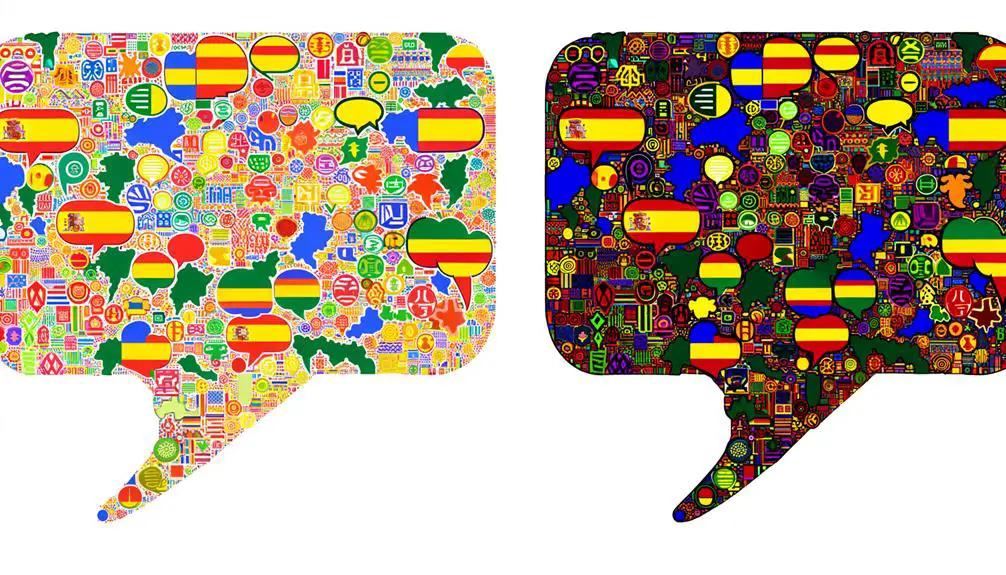When communicating with native Spanish speakers, beware of the complexities of argot español, or Spanish slang. Mastering it is key to building relationships and avoiding misunderstandings. You'll soon realize that slang serves as a form of social bonding and shared identity. However, regional variations, idioms, and expressions can be misinterpreted or offend if not used correctly. As you navigate the nuances of Spanish language and culture, you'll discover that awareness of regional argot differences and cultural contexts is essential for effective communication. Explore further to uncover the intricacies of Spanish slang and elevate your language skills.
Spanish Slang in Everyday Life

In your daily interactions with native Spanish speakers, you'll quickly discover that colloquial expressions and slang phrases permeate nearly every conversation. Understanding that these informal expressions aren't just random phrases; they've origins rooted in history, culture, and social context is crucial. Slang origins can be traced back to specific regions, social classes, or ethnic groups, making them an integral part of the language's diversity.
In daily conversations, you'll encounter slang phrases that serve as a form of social bonding, conveying a sense of belonging or shared identity. For instance, in some Latin American countries, using certain slang expressions can signal that you're part of the 'in-crowd' or familiar with local customs. Similarly, in Spain, regional slang can differentiate between urban and rural dialects.
Mastering these expressions can greatly enhance your communication, allowing you to navigate everyday conversations with confidence and authenticity. As you explore further into the world of Spanish slang, you'll uncover the rich cultural heritage and historical nuances underlying these colloquial expressions.
Common Pitfalls for Non-Natives
To navigate Spanish slang successfully, you'll likely stumble upon several pitfalls that can leave native speakers puzzled or even amused by your unintentional faux pas. As a non-native speaker, you're prone to language barriers that can lead to miscommunication.
One common pitfall is relying on literal translations, which can result in awkward or even offensive phrases. For instance, using the phrase 'tomar el pelo' (to take someone's hair) to mean 'to tease someone' can be misinterpreted as a literal action.
Another pitfall is making cultural assumptions based on your own cultural background. What may be acceptable in your culture may be offensive or inappropriate in Spanish-speaking cultures. For example, using the phrase 'hacer un negocio' (to make a deal) can be seen as overly formal or even suspicious in some contexts.
To avoid these pitfalls, immersing yourself in the language and culture, learning from native speakers, and being open to feedback are crucial. By being aware of these common pitfalls, you can improve your communication and build stronger relationships with native speakers.
Regional Argot Variations Matter

As you navigate the complexities of Spanish slang, you'll soon discover that regional variations can greatly impact the way you communicate with native speakers. Dialectal differences can be a significant obstacle, and understanding these geographical variations is essential for effective communication.
| Region | Slang Expression | Meaning |
|---|---|---|
| Madrid | 'Guay' | Cool/Good |
| Mexico City | 'Chido' | Cool/Good |
| Buenos Aires | 'Boludo' | Dude/Buddy |
For instance, in Madrid, 'guay' is a common expression meaning 'cool' or 'good.' However, in Mexico City, the same expression is replaced with 'chido,' conveying the same meaning. Meanwhile, in Buenos Aires, 'boludo' is used to address a friend or acquaintance, similar to 'dude' or 'buddy.' These regional argot variations can lead to misunderstandings if not understood correctly. As you explore further into Spanish slang, recognizing these dialectal differences will help you better connect with native speakers and avoid unintentional offenses. By being aware of these geographical variations, you'll be better equipped to navigate the complexities of Spanish slang.
Idioms and Expressions to Avoid
When exploring Spanish slang, it's important to be aware of idioms and expressions that can be misinterpreted or offend native speakers. You might unintentionally commit a cultural faux pas, causing embarrassment or offense.
Certain topics, like politics or religion, are considered taboo and should be approached with caution. Avoid using idioms that may be region-specific or have different connotations in various Latin American countries.
Be mindful of expressions that might be offensive or inappropriate in certain contexts. For instance, using phrases with double meanings or innuendos can lead to misinterpretation. Understanding the nuances of each expression and the cultural context in which they're used is key.
Steer clear of idioms that may be perceived as insensitive, racist, or sexist.
Formality in Formal Settings

How formal must you be in formal settings, such as business meetings or academic presentations, to guarantee your Spanish communication is effective and respectful? In formal settings, it's important to maintain a professional tone to avoid misunderstandings and make sure your message is conveyed effectively.
| Formality Norms | Examples |
|---|---|
| Use of formal titles (e.g., Señor/Señora) | Addressing a business partner as Señor García |
| Avoid colloquial expressions | Using '¿Cómo estás?' instead of '¿Qué onda?' |
| Formal verb conjugation (e.g., Ud.) | Saying '¿Puedo ayudarle?' instead of '¿Puedo ayudarte?' |
| Avoid slang and idioms | Using 'reunión' instead of 'chapa' for meeting |
In formal settings, it's important to adhere to formality norms to show respect and maintain a professional image. By using formal titles, avoiding colloquial expressions, and opting for formal verb conjugation, you can make sure your communication is effective and respectful. Remember, in business and academic settings, a professional tone is key to making a good impression and achieving your goals.
Slang in Latin American Countries
You'll encounter a wide range of slang expressions in Latin American countries, which can be challenging to navigate, even for fluent Spanish speakers. As you travel across country borders, you'll notice that slang evolution varies greatly from one region to another.
What's cool in Mexico mightn't be cool in Argentina, and what's trendy in Colombia mightn't be trendy in Chile. For instance, in Mexico, you'll hear ' Güey' (dude) a lot, while in Argentina, 'Che' is the preferred term.
In Colombia, 'Parce' (buddy) is commonly used, and in Chile, 'Pololo' refers to a boyfriend. Understanding these regional differences is important for communicating effectively with locals. Failing to do so might lead to confusion, miscommunication, or even unintentionally offending someone.
As you explore Latin America, be prepared to learn and adapt to the local slang. It's vital to recognize that slang evolution is a dynamic process, and staying up-to-date with the latest expressions will help you better connect with the people and cultures you encounter.
Cultural Nuances in Language

Recognizing the importance of understanding cultural nuances embedded in language can be equally perplexing, requiring a deep understanding of local customs, history, and values to navigate everyday conversations effectively.
You may find yourself lost in translation, struggling to grasp the subtleties of language that are deeply rooted in cultural identity. This language barrier can lead to misunderstandings, miscommunications, and unintentional offense.
To avoid these pitfalls, acknowledging that language isn't just a means of communication but also a reflection of cultural identity is crucial. You need to be mindful of the cultural nuances embedded in everyday expressions, idioms, and phrases.
For instance, what may seem like a harmless phrase in one culture can be offensive in another. By acknowledging and respecting these differences, you can bridge the language barrier and communicate more effectively.
Tips for Mastering Argot Español
To master argot español, start by familiarizing yourself with the different regional dialects and expressions that vary greatly across Spain and Latin America. This will help you understand the nuances of each region's slang and idioms.
Next, immerse yourself in the language by listening to native speakers, watching Spanish-language TV shows and movies, and practicing with language exchange partners. This will help you get a feel for the natural flow and rhythm of the language.
| Region | Dialect | Accent |
|---|---|---|
| Spain | Castilian | Neutral |
| Argentina | Rioplatense | Strong "ll" and "y" sounds |
| Mexico | Mexican Spanish | Soft "c" and "z" sounds |
Frequently Asked Questions
How Do I Respond to "¿Qué Onda?" in a Casual Conversation?
You're caught off guard when someone asks '¿quién onda?' in a casual conversation. Suddenly, you're under pressure to respond. Don't panic!
This phrase is a casual way of asking 'what's up?' or 'how's it going?'
You can respond with a relaxed tone, using phrases like 'nada, ¿y tú?' (nothing, and you?) or 'todo bien' (all good).
Be mindful of cultural nuances, and remember that casual responses are essential for maneuvering everyday conversations in Spanish.
Are There Any Spanish Slang Words That Are Universally Understood?
When exploring Spanish slang, you'll find that some expressions are universally understood, while others are region-specific. You'll notice that global expressions like '¿Qué onda?' (what's up?) or 'chido' (cool) are widely recognized.
However, regional nuances come into play with terms like 'guapo' (handsome) in Spain or 'bacano' (cool) in Chile. Be aware of these differences to navigate casual conversations with ease.
Can I Use Slang in Formal Writing, Like Emails or Reports?
As you navigate the world of professional communication, you're wise to wonder if slang has a place in formal writing.
Think of your writing as a suit – it should be tailored to the occasion. In emails and reports, a formal tone is key. Leave slang at the door, opting for professional language that conveys respect and credibility.
Reserve slang for casual chats with friends, where it's a colorful accent, not a distraction.
How Does Spanish Slang Differ Between Latin American Countries?
When exploring Spanish slang, you'll find that regional dialects and cultural influences shape the language differently across Latin American countries. You'll notice that each country has its unique flavor, reflecting local customs, history, and geography.
For instance, Argentine Spanish is peppered with Italian influences, while Mexican Spanish has a strong indigenous flavor. As you investigate further, you'll discover that cultural nuances and historical events have molded the slang, making each country's dialect distinct and fascinating.
Is It Impolite to Use Slang With Someone I've Just Met?
When you meet someone new, you're torn between being cool and being respectful.
Using slang with someone you've just met can be a cultural minefield. In some Latin American countries, slang is a social lubricant, while in others, it's seen as unprofessional.
In professional settings, it's generally safer to avoid slang, opting for more formal language instead.
Be aware of cultural differences in slang to avoid unintentionally offending someone.







